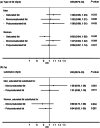Diet and risk of gastro-oesophageal reflux disease in the Melbourne Collaborative Cohort Study
- PMID: 33472714
- PMCID: PMC11082811
- DOI: 10.1017/S1368980021000197
Diet and risk of gastro-oesophageal reflux disease in the Melbourne Collaborative Cohort Study
Abstract
Objective: To examine associations between diet and risk of developing gastro-oesophageal reflux disease (GERD).
Design: Prospective cohort with a median follow-up of 15·8 years. Baseline diet was measured using a FFQ. GERD was defined as self-reported current or history of daily heartburn or acid regurgitation beginning at least 2 years after baseline. Sex-specific logistic regressions were performed to estimate OR for GERD associated with diet quality scores and intakes of nutrients, food groups and individual foods and beverages. The effect of substituting saturated fat for monounsaturated or polyunsaturated fat on GERD risk was examined.
Setting: Melbourne, Australia.
Participants: A cohort of 20 926 participants (62 % women) aged 40-59 years at recruitment between 1990 and 1994.
Results: For men, total fat intake was associated with increased risk of GERD (OR 1·05 per 5 g/d; 95 % CI 1·01, 1·09; P = 0·016), whereas total carbohydrate (OR 0·89 per 30 g/d; 95 % CI 0·82, 0·98; P = 0·010) and starch intakes (OR 0·84 per 30 g/d; 95 % CI 0·75, 0·94; P = 0·005) were associated with reduced risk. Nutrients were not associated with risk for women. For both sexes, substituting saturated fat for polyunsaturated or monounsaturated fat did not change risk. For both sexes, fish, chicken, cruciferous vegetables and carbonated beverages were associated with increased risk, whereas total fruit and citrus were associated with reduced risk. No association was observed with diet quality scores.
Conclusions: Diet is a possible risk factor for GERD, but food considered as triggers of GERD symptoms might not necessarily contribute to disease development. Potential differential associations for men and women warrant further investigation.
Keywords: Carbonated beverages; Diet; Fat; Gastro-oesophageal reflux disease; Prospective cohort study.
Figures



References
-
- Vakil N, van Zanten SV, Kahrilas P et al. (2006) The Montreal definition and classification of gastroesophageal reflux disease: a global evidence-based consensus. Am J Gastroenterol 101, 1900–1920. - PubMed
-
- Vakil N (2010) Disease definition, clinical manifestations, epidemiology and natural history of GERD. Best Pract Res Clin Gastroenterol 24, 759–764. - PubMed
-
- Revicki DA, Wood M, Maton PN et al. (1998) The impact of gastroesophageal reflux disease on health-related quality of life 1. Am J Med 104, 252–258. - PubMed
-
- Ronkainen J, Aro P, Storskrubb T et al. (2006) Gastro-oesophageal reflux symptoms and health-related quality of life in the adult general population – the Kalixanda study. Aliment Pharmacol Ther 23, 1725–1733. - PubMed
-
- Coleman HG, Xie SH & Lagergren J (2018) The epidemiology of esophageal adenocarcinoma. Gastroenterology 154, 390–405. - PubMed
Publication types
MeSH terms
LinkOut - more resources
Full Text Sources
Other Literature Sources
Medical

